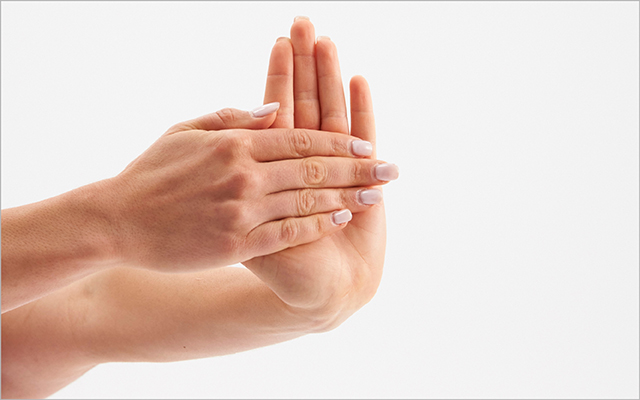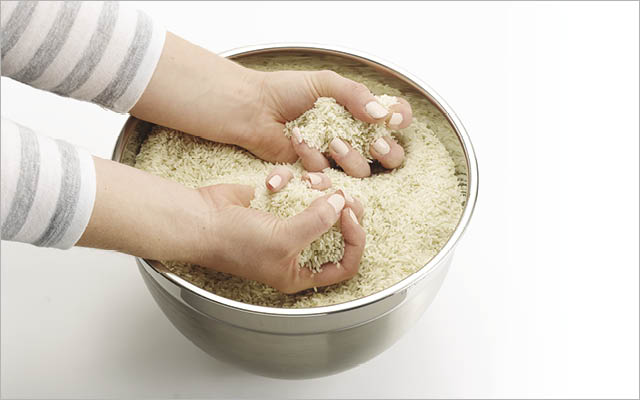Go to: 6 Tips to Build Grip Strength
Many of us take our grip for granted, yet building that strength is a simple way to keep our joints, muscles, and bones working to their full potential. Plus, studies find that a strong grip is an indicator of overall health and longevity.
Our hands serve as the first point of contact for many everyday movements, especially those that involve holding, lifting, pulling, and carrying objects. Whether we’re moving a couch, walking the dog, opening a jar, or swinging a golf club, strong muscles and healthy joints in the hands, wrists, and forearms all play a major role.
Improving grip strength may even help us unlock performance benefits when we’re participating in activities like strength training, tennis, bowling, or rock climbing.
“You’re only as strong as your weakest link,” says Cori Lefkowith, NASM, a personal trainer in Mission Viejo, Calif. If you have a tough time gripping a weight or a tennis racket, or your hand cramps when you’re climbing, you won’t be able to do as much as someone with a stronger grip.
By improving your grip strength, you may be able to lift heavier, climb higher, or serve faster.
Grip strength is also a reliable marker of longevity. A large-scale study published in 2015 found it to be a better predictor for all-cause and cardiovascular-related death than systolic blood pressure (how hard your blood pushes against your artery walls when your heart beats).
It offers a window into overall strength and muscle mass, both of which decline with age and inactivity. And sedentary behavior is one of the primary risk factors for heart disease and death by any cause that you can control.
The less active you are, in other words, the less strength and muscle mass you will retain, and the weaker your grip will become. Over time, this loss of strength and muscle can make it harder to do things like get up from a chair, carry groceries, and play sports, “which can lead to health problems and a decreased quality of life,” says Chris Gagliardi, CPT, of the American Council on Exercise.
Training your grip may also help resolve existing hand and wrist issues. “Performing exercises to improve grip strength may improve the health of the muscles that support the hand and wrist, and relieve symptoms,” Gagliardi says.(For wrist-mobility exercises, check out “6 Moves to Relieve and Prevent Wrist Pain“.)
Yet grip exercises alone won’t heal carpal tunnel syndrome, osteoarthritis, or similar problems. Working on wrist, elbow, and shoulder mobility is equally important, Lefkowith says. In fact, simply focusing on your grip could magnify symptoms of these conditions.
So, as you work on strengthening your grip, be sure to care for all the muscles and joints involved. Lefkowith recommends regularly stretching out your wrists, foam-rolling your forearms, and performing shoulder-mobility exercises. (For a shoulder-mobility routine, visit “A 5-Minute Workout to Protect Your Shoulders“.
If you’re unsure whether grip work is right for you, consult with your trainer or a medical professional before starting.
6 Tips to Build Grip Strength
When it comes to improving grip strength, many people consider isolation exercises the best route. These might include using a grip-strengthening device, squeezing a tennis ball in your palm, or stretching a thick rubber band looped around your fingers.
There’s a place for isolation work, but our experts prefer incorporating grip work into functional, full-body exercises. Gagliardi and Lefkowith share some of their favorite tips.
1. Mix Up Your Handles
If you lift weights, simple tweaks to your equipment can add an extra grip challenge, says Gagliardi. For example, if you normally do rows with a dumbbell, try using a kettlebell (or try the gorilla row). Or choose a barbell with a thinner or thicker diameter — swapping a 45-lb. barbell for a 35-lb. one, or mixing in some reps with an axle (“fat”) bar. Companies like Fat Gripz make sleeves to wrap around handles to increase their diameter.
For a different challenge, tie a dishcloth or gym towel around the handle of your dumbbell or kettlebell — or use a towel in place of a standard cable-machine attachment. This will help you strengthen your grip during rows, carries, biceps curls, pull-ups, swings, and deadlifts.
2. Take a Heavy Walk
One of Lefkowith’s favorite moves for grip and overall strengthening is the farmer’s carry. Pick up something heavy in one or both hands — a kettlebell, heavy bucket or can of paint, sandbag, weight plate, or packed suitcase or duffel bag are all great options. Hold the weight by your side(s), making sure that you’re not leaning to either side, hunching forward, or leaning back. Stand tall, shoulders away from your ears, and start walking. Set the weight down gently once you feel your grip loosen or your form deteriorate.
(For more carry cues and variations, visit “How to Do a Kettlebell Carry“.)
3. Hang Out in a Dead Hang
If you have access to a pull-up bar or monkey bars at a playground, try dead hangs or pull-up holds to build grip strength, Lefkowith says. To do a dead hang, jump or step up to grasp the bar with both hands; hang straight-armed for as long as possible, taking care to retract your scapulas to draw your shoulders down and back away from your ears. Add a challenge to the hang by doing a pull-up and holding the top position. (For more of the benefits of this often-overlooked move, see “The Benefits of the Dead Hang.”)
4. Reverse Your Biceps Curl
In this biceps-curl variation, instead of starting with palms facing away from your body, begin with palms turned toward your body. You can use dumbbells, a barbell, or an EZ bar for this challenging move.
(Explore these other biceps variations.)
5. Flip Your Kettlebell
The bottoms-up kettlebell press does double duty as both a grip strengthener and a shoulder mobilizer. Start with a light kettlebell and hold it upside down in one hand at shoulder height. When held upside down, the kettlebell will want to sway and fall back into a traditional rack position; keeping it bottom-side up will require your hand, shoulder, and core to engage. Once you have balanced the kettlebell at shoulder height, press it overhead in a straight line, taking care to keep your hips and shoulders level. Reverse the move and repeat.
(For a refresher on overhead-press form, visit “How to Do the Overhead Press“.)
6. Grab Some Battle Ropes
Battle ropes are typically used for muscular and cardio conditioning, but simply holding onto the ropes can be a challenge. Grasp an end of the rope in each hand and try doing double waves (simultaneously moving both arms up and down rapidly) and alternating waves (raising one arm up while lowering the other).
( For a battle-rope workout, visit “Using Battle Ropes“.)
Bonus
Try this simple, yet effective, at-home exercise to improve strength, mobility, and endurance in your hands, wrists, and forearms.
This article originally appeared as “Get a Grip” in the May 2021 issue of Experience Life.





This Post Has One Comment
I’m over 73 and do some of your suggestions and they work. I can dead hang for 90 seconds and do the peacock poise. Pushups have helped me get stronger also.